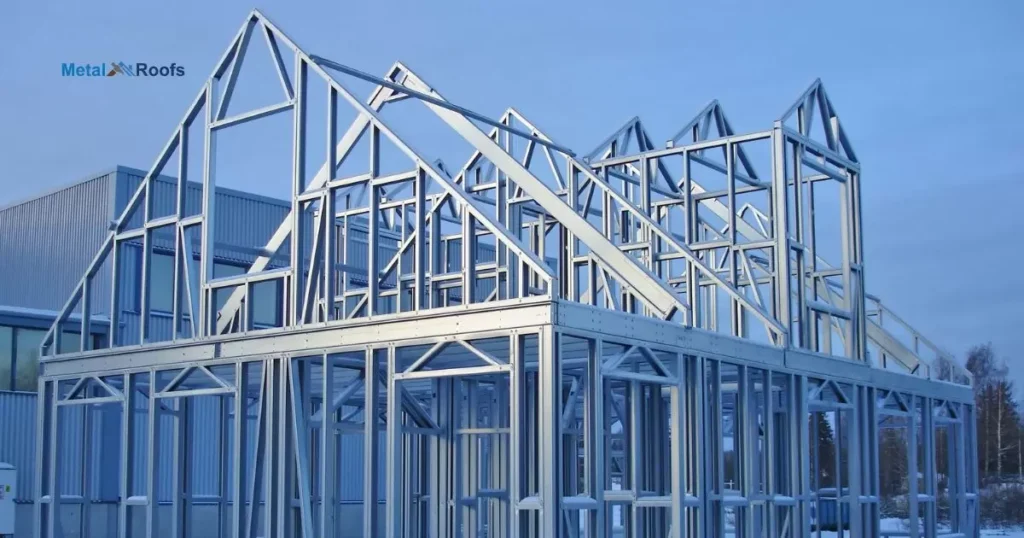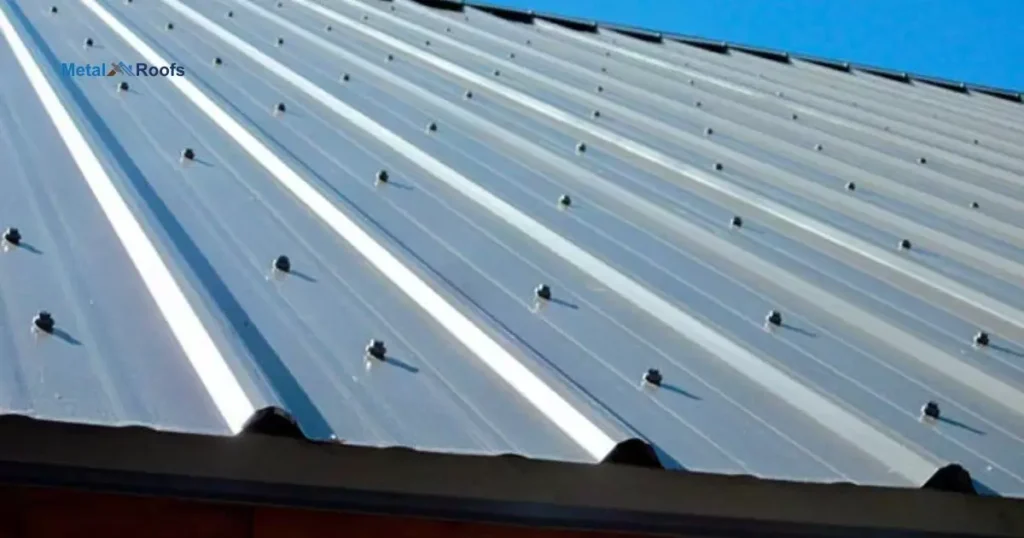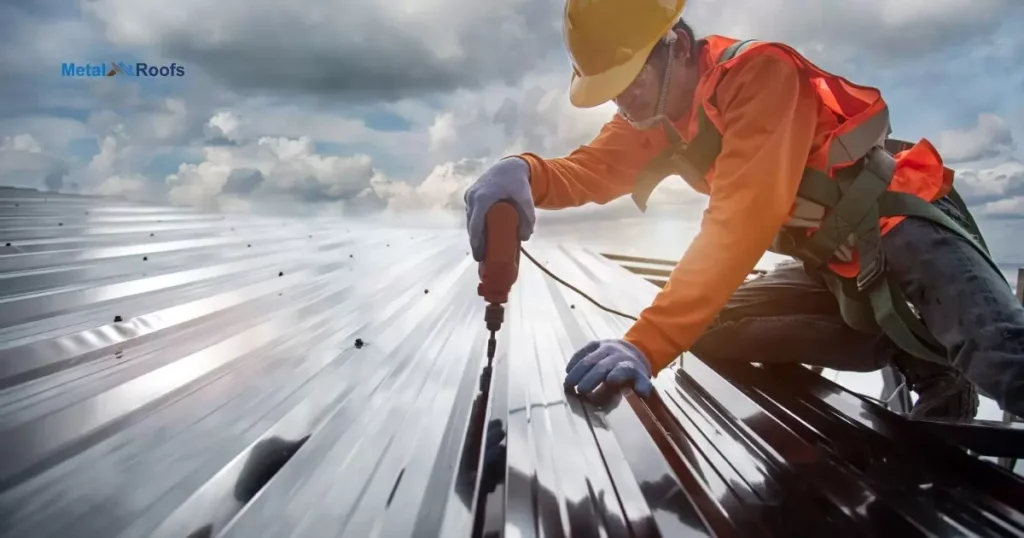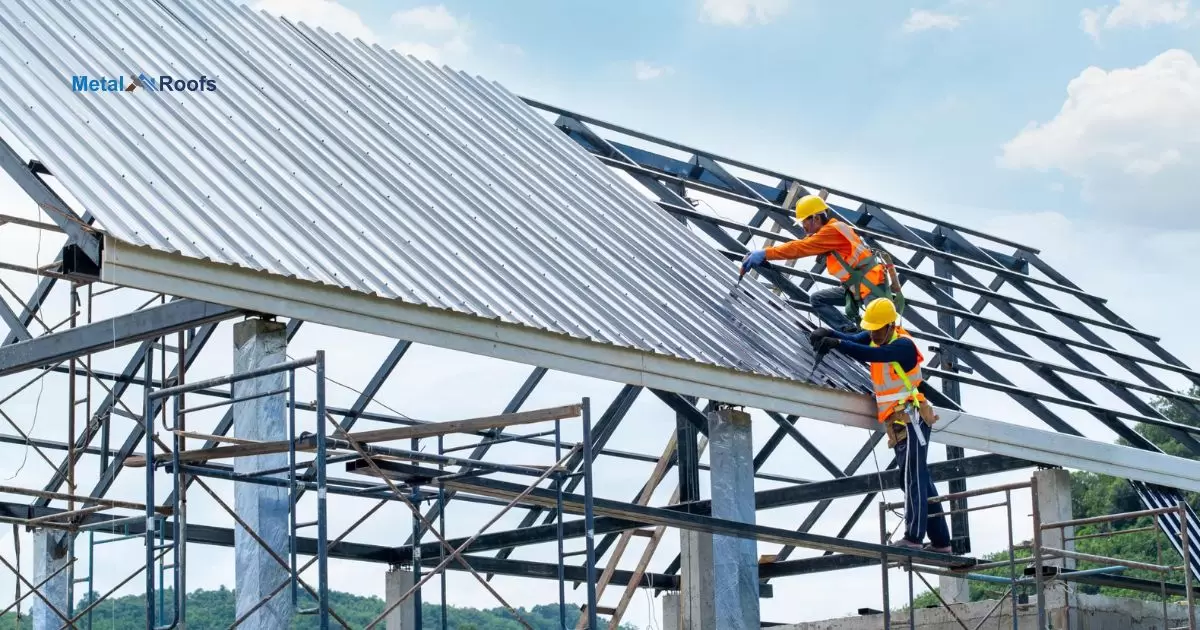Metal roofing directly on rafters is a method where metal panels or shingles are installed directly over the rafters, eliminating the need for sheathing or underlayment. This approach offers a durable, long-lasting solution for residential and commercial buildings. Proper installation, ventilation, and flashing are crucial for a successful metal roof installation on rafters.
Can you put metal roofing directly on rafters? Yes, it’s possible. This installation method skips sheathing and underlayment. Metal panels attach directly to exposed rafters. It offers durability and longevity. But correct ventilation and flashing are crucial. Proper installation prevents moisture issues.
The direct-to-rafter metal roofing installation method has pros and cons. It saves on materials and labor costs. But it requires careful planning and execution. Adequate ventilation and flashing are essential for long-term performance.
Key Takeaways
- Metal roofing can be installed directly on rafters, but it’s not recommended.
- It’s better to install a solid sheathing or deck on the rafters first.
- Sheathing provides a flat, even surface for the metal roofing and improves insulation and structural support.
- Skipping sheathing can lead to issues with moisture, noise, and potential damage.
What Are Rafters?
Rafters are the angled beams that support a roof’s structure. They run from the ridge, or peak, of the roof to the eaves, or edges. Rafters are essential for distributing the weight of the roof and providing support. They also help shape the roof’s pitch, or slope, which affects how water drains off the roof.
Rafters provide the framework for roof coverings like shingles or metal roofing, crucial for a building’s stability. Obtaining a permit to replace a roof is often necessary to comply with regulations and safety standards.
Advantages of Metal Roofing
Metal roofing offers several advantages, including:
Durability: Metal roofs can last 40-70 years, depending on the material. They are resistant to cracking, shrinking, and eroding, and can withstand extreme weather conditions such as heavy snow, hail, and high winds.
Energy Efficiency: Metal roofs reflect solar radiant heat, which can reduce cooling costs by 10-25%. Some metal roofs are Energy Star rated, providing further energy savings.
Environmentally Friendly: Metal roofing is often made from recycled materials and is fully recyclable at the end of its life. It can also be installed over an existing roof, reducing waste.
Fire Resistance: Metal roofs are non-combustible and have a Class A fire rating, which is the highest rating available.
Low Maintenance: Metal roofs require minimal maintenance over their lifespan. They are resistant to mildew, insects, and rot.
Lightweight: Metal roofing is lighter than most other roofing materials, putting less stress on the structure of the building.
Aesthetic Appeal: Metal roofs come in a variety of styles, colors, and finishes, allowing for customization to match the aesthetic of any home or building.
Long-Term Cost Savings: Although the initial cost of metal roofing is higher than some other roofing materials, its durability and longevity often result in cost savings over time.
Building Codes and Regulations
| Building Codes and Regulations | Description |
| Building Codes | Standards set by local authorities for construction and safety. |
| Regulations | Rules governing various aspects of building design, materials, and practices. |
Building codes are rules that dictate how buildings are constructed and maintained. They ensure safety and functionality. These codes cover everything from structural integrity to fire safety and electrical systems. They vary by location and are enforced by local governments.
They detail requirements for materials, techniques, and standards. They help ensure buildings meet code requirements. Violating codes and regulations can result in fines or even closure of a building. It’s important to follow these rules to ensure safety and compliance.
Preparing the Rafters

Preparing the rafters for metal roofing is crucial for a durable and weather-resistant roof. Start by ensuring the rafters are structurally sound and evenly spaced. Next, install solid sheathing or decking to provide a flat surface for the metal roofing.
This step improves insulation and support for the roof while preventing potential issues like moisture buildup and noise. Skipping the sheathing can lead to long-term problems, so take the time to prepare the rafters properly before moving forward with the installation.
Installing Underlayment
When installing underlayment, it’s crucial to ensure a proper base. Start by laying down a layer of roofing felt or synthetic underlayment directly onto the rafters. This provides a barrier against moisture and enhances the roof’s durability.
Avoid putting metal roofing directly on rafters. Without underlayment, the metal can corrode over time due to exposure to moisture. Plus, underlayment serves as an extra layer of protection against leaks, enhancing the roof’s longevity and performance.
Attaching Furring Strips
When installing metal roofing, attaching furring strips is crucial. These strips create a level surface for the roofing material. Start by securing the strips perpendicular to the rafters. Use screws or nails to fasten them securely. Ensure the spacing between strips meets the manufacturer’s guidelines.
Next, apply the roofing material directly to the furring strips. This method allows for proper ventilation and drainage. It also helps prevent moisture buildup, extending the life of your roof. Following these steps ensures a durable and long-lasting metal roof.
Fastening the Metal Roof

To fasten a metal roof, start by laying down a layer of underlayment over the sheathing. Next, use screws or nails to secure the metal panels to the roof deck, placing fasteners in the designated spots on each panel. It’s important to use the correct type and length of fasteners to ensure a secure installation.
Overdriving the fasteners can cause damage, while underdriving can lead to leaks. Be sure to follow the manufacturer’s instructions for fastening the metal roofing to achieve the best results.
Alternative Methods
When it comes to roofing, there are alternative methods to consider. One option is using metal roofing directly on rafters, but it’s not the best practice. Another approach is to install a solid sheathing or deck on the rafters before adding the metal roofing. This provides a flat surface for the roofing and improves insulation and support.
Skipping this step can lead to problems like moisture buildup, increased noise, and potential damage to the metal roofing over time. It’s important to weigh these factors when deciding on the best method for your roofing project.
Ventilation Considerations
When installing metal roofing directly on rafters, ventilation is crucial. Adequate ventilation helps prevent moisture buildup, which can lead to mold and rot. It also helps regulate temperature, improving energy efficiency and comfort.
To ensure proper ventilation, install vents along the eaves and ridge of the roof. This allows air to flow in through the eaves and out through the ridge, carrying moisture and heat away. Consider using vented metal roofing panels, which have built-in ventilation channels. These channels allow air to circulate beneath the panels, further enhancing ventilation and prolonging the life of the roof.
Insulation Options
When considering installing metal roofing directly on rafters, insulation is an essential factor. Proper insulation helps regulate temperature and improve energy efficiency. One option is to use rigid foam insulation installed between the rafters.
This provides effective thermal insulation and helps prevent heat loss in the winter and heat gain in the summer. Another option is to use reflective insulation installed beneath the metal roofing panels. Reflective insulation helps reflect radiant heat away from the roof, keeping the interior cooler in hot weather.
Maintenance and Care

When considering installing metal roofing directly on rafters, maintenance and care are essential. Regular inspection of the roof is necessary to identify any signs of damage or wear. Prompt repairs can prevent issues from escalating and prolong the lifespan of the roof.
Keep the roof clean from debris and inspect it for rust or corrosion. Apply a protective coating if needed to maintain its integrity. Additionally, trim overhanging branches to prevent damage from falling debris. With proper maintenance, a metal roof installed on rafters can provide long-lasting protection for your home.
Frequently Asked Questions
Do you need plywood under a metal roof?
Yes, it’s recommended to use plywood or another solid sheathing under the metal roofing for structural support and to provide a flat, even surface.
Should I put anything under a metal roof?
Yes, it’s recommended to put a solid sheathing or deck under a metal roof.
Do I need furring strips under a metal roof?
Yes, you may need furring strips under a metal roof to provide a level surface and allow for proper ventilation.
Conclusion
In conclusion, metal roofing directly on rafters is a viable option for many projects. It offers durability and longevity when installed correctly. Proper ventilation and flashing are critical for preventing moisture issues. This method can save on material and labor costs.
Careful planning and execution are crucial for a successful installation. Seek professional guidance to ensure compliance with building codes and manufacturer guidelines. With the right approach, a direct-to-rafter metal roof can provide long-lasting protection for your structure.











